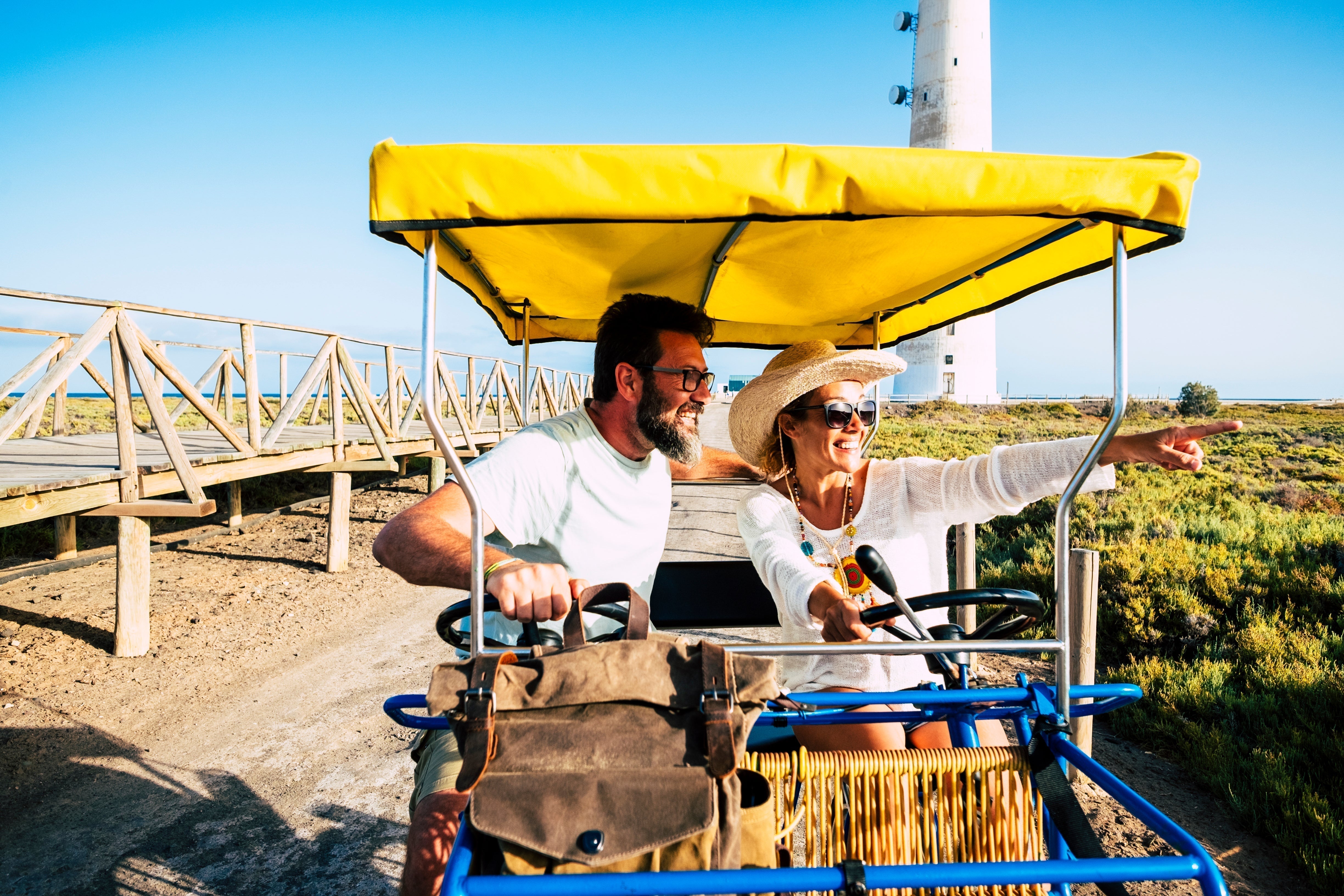Keeping up with your fitness routine while you're traveling can feel like a significant challenge. It may sound impossible, but you can maintain fitness during travel.
With a little creativity and planning, you can stay fit and fabulous no matter where on earth your adventures take you!
Whether you're jetting off on a business trip or hitting the road for a family vacation, maintaining your fitness during travel is crucial for your physical and mental well-being.
It helps you stay healthy, keeps your energy levels up, and lets you fully enjoy your trip without feeling sluggish. So, let's explore some practical tips and tricks to help you stay on track with your fitness goals, even when you're miles away from your usual gym or routine.
Pack Smart: Your Portable Gym
First, let's talk about what to pack for light travel. You don't need to lug around your entire home gym. A few small, lightweight items can make a world of difference in your ability to perform a hotel room workout or squeeze in fitness routines.

Resistance Bands: Your New Best Friend
Resistance bands are a traveler's dream for staying fit. They're lightweight, take up minimal space in your luggage, and can provide a full-body workout.
You can use them for strength training exercises targeting your upper body and lower body, stretching, or even as a warm-up tool before a run or a bodyweight workout. Different types of bands, such as loop bands or tube bands with handles, offer varied resistance levels.
This versatility lets you perform exercises like bicep curls, squats, assisted pull-ups, and even dumbbell row adaptations. They're an indispensible (and inexpensive) tool for anyone who travels.
Jump Rope: Cardio in Your Pocket
A jump rope is another fantastic minimalistic travel fitness tool for your workout routine. It's compact, affordable, and gives you a killer cardio workout in minutes.
Plus, you can use it almost anywhere – your hotel room, a nearby park, rest areas, or even an empty hallway during flight delays. It's a great way to get your blood moving after sitting in a plane or car for hours.
Beyond just cardio, jumping rope improves coordination, balance, agility, and bone density. It's a highly efficient way to burn calories and elevate your heart rate quickly. Just a few minutes can make a big impact on your travel day.
Yoga Mat: For More Than Just Yoga
A thin, foldable travel yoga mat can be a game-changer for your fitness routine. Use it for yoga, of course, but also for bodyweight exercises like squats, push-ups, or reverse crunches, providing a clean and cushioned surface.
It's also great for stretching or even as a clean spot for outdoor workouts if you find yourself near a park. Look for mats specifically designed for travel, as they're lighter and more compact.
Having your own mat ensures a hygienic space for your floor exercises, no matter where you are. It also helps you mentally switch into workout mode, even in an unfamiliar hotel room.
Other Light Travel Gear
Some travelers also pack inflatable fitness balls or small massage balls for muscle release after a long travel day or an intense workout. The key is to choose items that are versatile and don't add significant weight or bulk to your luggage.

Bodyweight Exercises: No Equipment, No Problem
Don't have space for even these small items, or prefer an equipment-free approach to staying fit? No worries. Your body is all the equipment you need for an effective bodyweight workout, ensuring you can maintain fitness anywhere, anytime.
Bodyweight workouts are incredibly versatile and can be adapted to any fitness level. They are perfect for a quick hotel room workout or even a session in a quiet corner of an airport terminal during extra time.
Many people find bodyweight exercises like bodyweight squats and lunges sufficient to stay active.
The Ultimate Travel-Friendly Workout
Try this simple yet effective routine that requires zero equipment. This bodyweight workout targets multiple muscle groups for a comprehensive session. Remember to warm up before you start revving up those reps and cool down afterwards.
Here's a sample bodyweight circuit:
- 20 Bodyweight squats (focus on form, keeping your back straight).
- 15 Push-ups (or knee push-ups if standard ones are too challenging).
- 30-60 second Plank (engage your core, keep your body in a straight line).
- 15 Walking lunges (each leg, ensuring your front knee stays behind your toes).
- 20 Mountain climbers (keep your core tight and movements controlled).
- 15 Reverse crunches (lie on your back, lift your hips off the floor, keeping your legs straight or bent).
- 30 Jumping jacks (a great way to get your heart rate up).
Repeat this circuit 3 to 5 times for a quick, effective full-body workout. You can do this in your hotel room, at the beach, or in a park.
Making Bodyweight Workouts Challenging
To keep making progress with bodyweight workouts, keep increasing the challenge. Try slowing down the tempo of each exercise, increasing the number of reps or sets, or reducing rest times between sets.
You can also explore more advanced variations, like pistol squats or incline push-ups using furniture. Isometric holds, like holding a squat or lunge position, can also add intensity. The goal is to keep your body pushing its limits safely.
Perfecting Your Hotel Room Workout
Your hotel room can become your private gym. Use the space creatively for your room workout. Clear a small area, put on some music, and focus on your movements.
Consider exercises like burpees, tricep dips using a chair, or glute bridges on the floor. A dedicated hotel room workout can be surprisingly effective. Make sure the furniture you use is stable and the area is free of obstacles to prevent injury.

Make Your Surroundings Work for You
Get creative with your environment when you're traveling. Your hotel room, Airbnb, or even the local park can be transformed into a mini gym with a little imagination. This is key to staying fit without relying on traditional gym access. And in fact, many hotels offer a gym for no extra charge. That info is usually on their website.
Stair Power
If your accommodation has stairs, you've got yourself a built-in StairMaster. Running or walking up and down stairs is an excellent cardio workout that also tones your legs and glutes.
This simple activity can significantly contribute to your daily movement goals. Simply choosing stairs instead of the elevator can notch up your steps during travel.
Use Walls for Support and Resistance
Use a wall for wall sits, an excellent isometric exercise for your quads. You can also do wall push-ups, which are a good modification if regular push-ups are too difficult. Walls can support your balance during standing stretches or single-leg exercises.
Consider wall slides for shoulder mobility or calf stretches against the wall. These simple exercises require no equipment and can be done in the privacy of your room.
Explore on Foot: Your Active Sightseeing Strategy
One of the easiest ways to stay fit while traveling is to turn sightseeing into an opportunity for movement. Walking or jogging lets you explore a new city while getting your steps in—blending physical activity with cultural discovery.
Skip the taxi or subway and walk whenever possible. You’ll boost your activity levels and uncover hidden spots you might otherwise overlook. You're moving slower past the sights too, so you're actually taking in the culture on a deeper level. Some people who choose to walk instead of taking the train in European cities can log upwards of 8 or 10 miles a day. A good way to stay active while traveling.
Immersive Walking Tours
Many cities offer walking tours, focusing on history, architecture, or food. A walking tour is a win-win, you learn about the local culture and history while getting a good workout. Look for tours that align with your interests and fitness level.
Some tours can last several hours and cover considerable distances. This is an excellent way to stay active, especially on days when you might not have time for a dedicated workout. It makes fitness a natural part of your travel experience.
Set Daily Step Goals
Use a pedometer or a fitness tracker to monitor your daily steps. Set a reasonable goal for each day exploring. This can be a great motivator to choose walking over other transport options.
Even if you don't hit a specific number, staying mindful of your step count encourages more movement.

Hydration and Nutrition: Fueling Your Travels Right
Staying hydrated and eating well are crucial parts of maintaining your fitness during travel and ensuring you stay healthy. It's easy to get caught up in trying local cuisines (which you absolutely should) but you'll want to avoid nutritionally poor meals, and don't overindulge.
Stay Hydrated: The Foundation of Travel Wellness
Carry a reusable water bottle with you and refill it often. Proper hydration helps maintain energy levels, aids digestion, and can help prevent overeating. Drink water consistently throughout the day.
Dehydration can exacerbate jet lag and make you feel sluggish. If you're in a hot climate or exercising a lot, increase your water intake. If you don't feel great, dehydration could be the culprit.
Smart Snacking: Stay Healthy on the Go
Pack healthy snacks like nuts, seeds, fruits, or protein bars (read labels on these). Beef jerky is another excellent protein source that travels well.
Having these on hand can help you avoid unhealthy airport or roadside food choices, preventing you from consuming crappy food.
If you use protein powder, consider packing single-serving sachets. Smart snacking helps maintain stable blood sugar levels and prevents energy crashes. This is especially important on a long travel day or during extended flight delays.
Healthy Eating While Experiencing New Cuisines
Enjoy local cuisine but practice mindful eating by watching portion sizes and making healthier choices when possible.
Aim for meals rich in vegetables, lean protein, and whole grains. Don’t hesitate to ask how food is prepared or to request simple changes like sauces on the side. To keep balance, if you indulge in one meal, choose something lighter for the next.
Avoid stacking multiple heavy meals in a row. Intermittent fasting—such as eating within an 8- to 10-hour window—can also help manage calorie intake while traveling without feeling restrictive.
Portion sizes in restaurants can be larger than you're used to at home, so consider sharing dishes or saving half for later. If your hotel has a fridge, ask for a to-go box.
Travel Day Fitness & Fighting Jet Lag
Long travel days can be draining, but adding small bursts of movement—like stretching, walking during layovers, or light hotel workouts—can make a big difference in how you feel.
Staying active also helps your body adjust more smoothly to jet lag, making fitness a useful tool for recovery and adaptation.

Navigating the Airport Terminal Actively
Use your time at the airport terminal wisely. Instead of sitting at the gate for hours, walk around. Explore the shops, do some stretches in a quiet corner, or find a less crowded area to do some lunges or calf raises.
Some airports even have designated yoga or workout rooms. Even if not, simply walking can help keep your blood flowing and reduce stiffness from prolonged sitting.
This is especially important during unexpected flight delays when you might have extra time.
In-Flight Movement and Wellness
During the flight, try to move regularly. Get up and walk the aisles every hour or so if possible. Perform simple stretches in your seat, like ankle circles, shoulder rolls, and neck stretches.
Stay hydrated by drinking plenty of water. Avoid excessive alcohol or caffeine, which can dehydrate you and make jet lag worse.
Adjusting to a New Time Zone
When you arrive at your destination, try to adjust to the local time zone as quickly as possible. If you arrive during daylight, get some sunlight exposure, which helps reset your internal clock.
A light workout can also help you feel more awake when your whole body is screaming that it's not. Sleep according to the new schedule and resist the urge to nap excessively the first day.
Use Technology to Your Advantage
In this digital age, there's an app for almost everything – including staying fit while traveling.
Leverage Fitness Apps
Apps like Nike Training Club, Seven, FitOn, or Fitbod offer many workouts you can do anywhere. Many of these apps have offline modes, so you can use them even without internet access.
Tap into YouTube Workouts
If you have internet access, YouTube is a goldmine of free workout videos. From yoga and Pilates to HIIT and strength training, you can find routines for any fitness level, duration, and interest.
Search for specific types of workouts, like "15-minute hotel room workout" or "no equipment upper body workout." Save a few videos offline if possible.
Wearable Technology Insights
Fitness trackers and smartwatches can be valuable tools while traveling. They can track your steps, monitor your heart rate, estimate calories burned, and even analyze your sleep quality.

Engage in Local Activities
Participate in local sports or physical activities unique to your destination. This could be surfing in Hawaii, hiking in the Alps, taking a salsa dance class in Colombia, or practicing Tai Chi in China.
It's a great way to stay active while immersing yourself in the local culture and creating lasting memories.
Research what activities are available at your destination before you go, or ask locals for recommendations. This makes your workout routine an exciting part of your adventure. You might discover a new passion while staying fit.
Work Out with a Travel Buddy
If you're traveling with friends, family, or colleagues, invite them to join your workouts or active explorations. Having a workout partner can provide motivation, accountability, and make exercising more enjoyable.
If your travel companions aren't interested in formal workouts, suggest active sightseeing options like a long walk through a scenic area, or a bike ride. Shared experiences often make fitness efforts more sustainable.
Planning Ahead: Key to Success
A little bit of planning can go a long way in helping you maintain fitness while traveling. Instead of leaving it to chance, make fitness part of your travel itinerary.
Set Realistic Expectations
Don't beat yourself up if you miss a workout or can't stick to your usual intensity; some movement is always better than none. Adjust your training program to fit your travel schedule and energy levels.
Schedule Your Workouts
Treat your workouts like important appointments by scheduling them into your day. This could mean waking up a bit earlier for a quick hotel room workout before a day of meetings or sightseeing.
Set a workout time to stay consistent, even when your days are packed.
Research Fitness Options at Your Destination Before You Leave
Before you leave on your trip, do a little research on fitness facilities or opportunities at your destination. See if your hotel has a gym or if there are any nearby fitness centers with day pass options.
Look for safe running or walking paths, parks, or secure areas where you can exercise outdoors nearby.
Conclusion
Maintaining fitness during travel doesn't have to be impossible. With planning, creativity, and the right mindset, you can successfully stay on track with your fitness goals while enjoying your travels to the fullest.
Value consistency over perfection when you're traveling, because something is always better than nothing. All movement is beneficial.
Enjoy the journey. That's what travel is all about!

Frequently Asked Questions
1. How can I stay in shape while traveling?
Stay fit while traveling by building movement into your day—walk instead of taking a cab, explore new cities on foot, and turn layovers into opportunities for activity. Pack light workout tools like resistance bands, a jump rope, or a yoga mat.
Schedule short workouts in your hotel room or outdoors and fuel your body with smart nutrition and hydration. Go for consistency over intensity—doing something is better than doing nothing.
2. What exercises are easy to do while traveling?
Bodyweight exercises are your go-to for travel: squats, push-ups, planks, lunges, mountain climbers, and jumping jacks. They require no equipment and can be done anywhere, from hotel rooms to parks.
Resistance band workouts and jump rope cardio are also easy and effective. Even walking, stair climbing, or stretching during flights and layovers makes a big difference.
3. What are the best ways to maintain an exercise routine when traveling?
Maintaining fitness during travel starts with planning ahead and staying flexible. Pack compact gear like resistance bands or a jump rope and use fitness apps or YouTube videos to guide your workouts.
Schedule short sessions into your day—whether in a hotel room, park, or airport—and turn activities like walking tours or hiking into part of your routine. Prioritize consistency over intensity to keep your fitness habits alive wherever you go.





Share:
Hospital Stays and the July Effect
Health Benefits of Outdoors